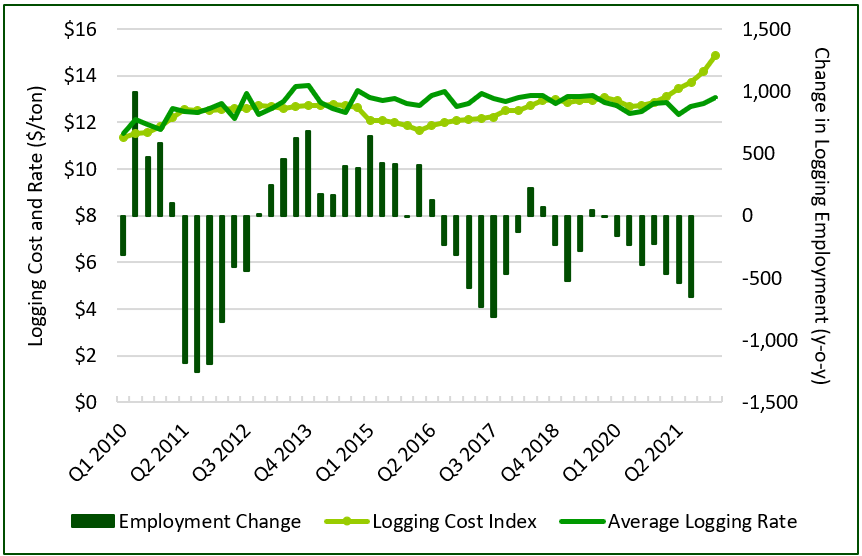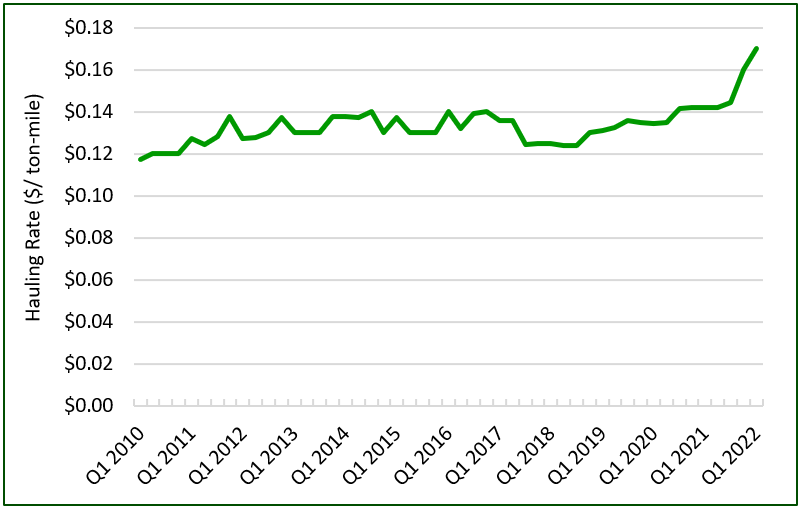This post is the fifth in a series related to the Q2 2022 Forisk Research Quarterly (FRQ), which includes forest industry analysis, timber price forecasts, and featured research on regional pulpwood price dynamics.
Logging is largely a high-volume, low-margin business. Production is critical to profit. Where costs are fixed, like payments on half-million dollar machines, squeezing extra production per hour, day, or week can offset those costs with increased revenue. However, more production means more consumption, and variable costs such as fuel and equipment repairs increase commensurately. Thus, the role of inflation on logging businesses depends on where those cost increases occur and how quickly. Fuel costs often get a large focus because prices can be volatile, and loggers cannot offset them with greater production. However, over the past two years, rapid inflation in wages, equipment, and insurance compounded to pressure logging costs at a faster clip than productivity can offset, and fuel and repair costs are pushing to record levels as well, creating a painful (and expensive) operating environment for the logging sector.

Figure 1 compares annual changes in southern logging employment to logging rates (amount loggers are paid for their work) and an index of logging costs (cost a logger incurs to operate their business) adjusted for average annual growth in productivity. It assumes labor costs are fixed (that employees are salaried), which is not entirely representative but provides the lowest cost assumption[1] for this example. Logging rates grew from 2010 through 2012 and oscillated +/- $0.50 per ton since[2]. Logging costs largely varied in the same range through 2020, excepting a diesel price drop in 2015. Since 2020, growth in logging costs far outpaced reported logging rates.

Year-over-year changes in southern logging employment speak to the volatility in the sector. Lost capacity following the Great Recession began to return in late 2012, and the margin between rates and costs helped fuel growth in the sector. Since 2016, the industry largely lost loggers. In 2021, the spread between increasing costs and logging rates widened and the pace of logging employment losses increased. Rapid inflation fueled cost growth in excess of growing productivity and flat logging rates. In contrast, log hauling, the portion of the supply chain receiving more attention over the past few years, saw rapidly increasing rates over the latter half of 2021 as fuel costs and labor shortages pushed costs higher (Figure 2).
[1] If labor were treated as entirely variable, total logging cost would be nearly $1 per ton higher in 2022. By adjusting costs for assumed productivity gains and using fixed labor costs, the pace of logging cost growth is extremely conservative.
[2] Reported logging rates are an average of clearcut and plantation thinning rates for the Piedmont from Timber Mart South.

Is this the cost of logging? You must factor in overhead and profit. The system is broken.